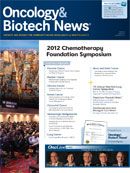Publication
Article
Oncology & Biotech News
Cardiac Risks Higher in Older Women Receiving Adjuvant Trastuzumab
Author(s):
A retrospective study of older women with early-stage breast cancer who received adjuvant trastuzumab alone or in combination with anthracyclines has revealed a higher incidence of heart failure and cardiomyopathy.
Jersey Chen, MD, MPH
A retrospective study of older women with early-stage breast cancer who received adjuvant trastuzumab alone or in combination with anthracyclines has revealed a higher incidence of heart failure (HF) and cardiomyopathy (CM) in these patients compared with older breast cancer patients who had no adjuvant therapy. The findings were published online in the Journal of the American College of Cardiology.
Cardiotoxicity is a particular concern for patients with breast cancer undergoing adjuvant therapy, because many commonly used drugs can cause left ventricular function abnormalities. Over 40% of women diagnosed with breast cancer in the United States are at least 65 years of age, yet the elderly have been underrepresented in trastuzumab clinical trials.
For the study, Jersey Chen, MD, MPH, assistant professor of Medicine at the Yale School of Medicine, New Haven, Connecticut, and colleagues used data from the National Cancer Institute’s SEER-Medicare database from 2000-2007 to identify 45,537 women aged 67 to 94 years (mean, 76.2 years) with early-stage breast cancer.
Because most patients treated with trastuzumab were treated from 2005 onward, investigators looked at cumulative incidence of HF or CM up to 3 years after breast cancer diagnosis. Incidence rates for HF or CM were calculated among five patient groups divided according to treatment approach: trastuzumab (with or without nonanthracycline chemotherapy); anthracycline plus trastuzumab (A+T); anthracycline (without trastuzumab and with or without nonanthracycline chemotherapy); other nonanthracycline chemotherapy; or no adjuvant chemotherapy or trastuzumab therapy.
One percent of the cohort received trastuzumab (n = 431); 0.9% received A+T (n = 437); 11.5% received anthracycline-based chemotherapy (n = 5257); 5.9% received nonanthracycline chemotherapy (n = 2712); and 36,700 (80.6%) received neither adjuvant chemotherapy nor trastuzumab.
Medicare claims data were used to determine cardiac events. At 3 years postdiagnosis, cumulative incidence of HF or CM was significantly higher (P <.001) for patients receiving trastuzumab (26.7 per 100 patients) and A+T (28.2 per 100 patients), compared with patients who received no adjuvant therapy (16.9 per 100 patients). Patients who received anthracyclines were less likely to have HF or CM compared with patients who received no adjuvant therapy (15.3 vs 16.9 per 100; P <.0001). The 3-year HF or CM incidence for patients who received other types of chemotherapy was not significantly different from patients who received no adjuvant therapy (17.0 vs. 16.9 per 100 patients; P = .89).
When adjusted for potential confounders, such as age, race, and marital status; breast cancer characteristics; cardiovascular conditions; and year of breast cancer diagnosis, the researchers reported adjusted 3-year incidence rates per 100 patients of 32.1 in the trastuzumab-only group; 41.9 in the A+T group; 20.2 in the anthracycline group; 19.2 for patients receiving nonanthracycline chemotherapy; and 18.1 in patients receiving no adjuvant therapy.
“Intrinsic differences in the mechanisms of cardiotoxicity may be one explanation for why the risk of developing HF or CM was higher with trastuzumab than with anthracycline therapy,” the researchers wrote, adding that another possible explanation for the difference could be that clinicians selected lowest-risk patients for anthracycline therapy due to its cardiotoxicity profile.
J Am Coll Cardiol
Chen J, Long JB, Hurria A, et al. Incidence of heart failure or cardiomyopathy after adjuvant trastuzumab therapy for breast cancer [published online ahead of print November 2, 2012]. . doi:10.1016/j.jacc.2012.07.068.




























%20(2)%201-Recovered-Recovered-Recovered-Recovered-Recovered-Recovered-Recovered-Recovered-Recovered-Recovered-Recovered-Recovered-Recovered-Recovered-Recovered-Recovered-Recovered.jpg?fit=crop&auto=format)
%20(2)%201-Recovered-Recovered-Recovered-Recovered-Recovered-Recovered-Recovered-Recovered-Recovered-Recovered-Recovered-Recovered-Recovered-Recovered-Recovered-Recovered-Recovered.jpg?fit=crop&auto=format)
